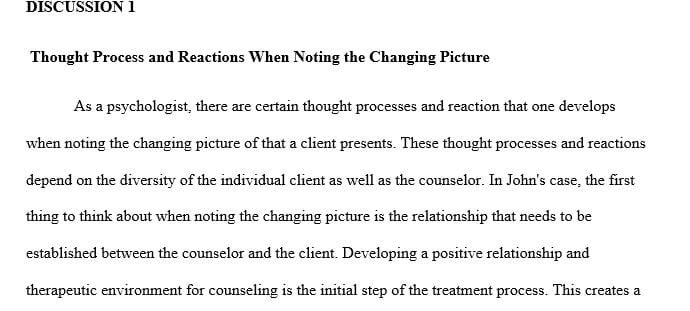Using the diathesis-stress model to assess John’s case what salient vulnerabilities and stressors come to mind
Discussion 1
CASE STUDY OF JOHN
The purpose of this discussion is to think through some of the ambiguities that can make the diagnostic process more complex than it might at first appear.
Begin by carefully reading the Case Study of John. Pay particular attention to how the psychologist’s diagnosis changes as the case unfolds and more information is available about John. Imagine how much more difficult accurate diagnosis would have been if you had followed a particular diagnosis prematurely.
What were your thought processes and reactions as you noted the changing picture presented in John’s case?
Using the diathesis-stress model to assess John’s case, what salient vulnerabilities and stressors come to mind?
Attempt a diagnosis for John, based on your current knowledge, providing the DSM-5 and ICD-10 codes, according to the format provided in Unit 1.
Some suggestions to help you prepare your initial post: Since you have not yet learned diagnostic specifics, just describe your evolving impressions in whatever terms seem the most accurately descriptive, and the reasons for those impressions. Turn to the DSM Decision Trees and DSM-5 diagnostic categories for assistance. A combination of narrative comment and a highlighted encoding DSM-5 diagnosis would work well.
Discussion 2
Refer to the Case Study Response Guide to assist you with this discussion.
RANGE OF INFORMATION IN DSM-5 DIAGNOSTIC TEXT
For this discussion, refer to the psychological diagnosis you chose to read for a single diagnostic code in DSM-5 text in the study in this unit (u02s1).
Each of us has a different background of experience. Keeping your experience level in mind, along with what you personally need to glean from such a diagnostic manual, please provide your analysis of how effectively the manual covered the following aspects of the diagnosis you read about.
Diagnostic features.
Subtypes and specifiers.
Associated features and disorders, including:
Laboratory findings.
Physical examination and general medical condition findings.
Culture, age, and gender features.
Prevalence.
Course of the disorder.
Familial pattern.
Differential diagnoses.
Diagnostic criteria.
Be sure to address what was effective and helpful in the DSM’s presentation, what you feel is missing or could be improved, any cultural or diversity issues that might be of concern, and what you personally need to know more about.
Solution preview for the order on using the diathesis-stress model to assess John’s case what salient vulnerabilities and stressors come to mind
APA
1560 words
